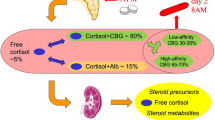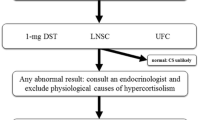Abstract
The dexamethasone (DXM) test has been widely used for diagnosing Cushing’s disease (CD). The purpose of this paper is to review its diagnostic merit based on calculation of data extracted from earlier publications. Studies presenting individual values for patients with CD and normal subjects were identified through PubMed searches and references in pertinent studies. Calculation of the retrieved data demonstrated huge variation in the relative suppressibility, negative suppression being common. Furthermore, in almost each study retrieved, the pre and post DXM values were closely correlated. Finally, the generally accepted view that DXM causes less suppression in Cushing’s disease than in euadrenal controls appears unfounded. A central issue in the definition of so-called “pseudo-Cushing’s states” is failure to suppress cortisol secretion with DXM. From analysis of the literature it appears quite possible that this does not reflect a specific endocrine deficit, but a physiological “stress” reaction. The above issues question the diagnostic value of the test, in particular in clinically and biochemically borderline cases.

Similar content being viewed by others
References
Lindholm J (2000) Cushing’s syndrome: historical aspects. Pituitary 3:97–104
Cushing H (1912) The pituitary body and its disorders, clinical states produced by disorders of the hypophysis cerebri. Lippincott, Philadelphia, pp 1–341
Cushing H (1932) The basophilic adenomas of the pituitary body and their clinical manifestations (pituitary basophilism). Bull Johns Hopkins Hosp 50:137–195
Kepler EJ (1949) Cushing’s disease: a primary disorder of the adrenal cortices. Ann NY Acad Sci 50:657–678
Bauer J (1950) The so-called Cushing’s syndrome, its history, terminology and differential diagnosis. Acta Med Scand 137:411–416
Norymberski JD, Stubbs RD, West HE (1953) Assessment of adrenocortical activity by assay of 17-ketogenic steroids in urine. Lancet 261:1276–1281
Porter CC, Silber RH (1950) A quantitative color reaction for cortisone and related 17:21-dihydroxy-20-ketosteroids. J Biol Chem 185:201–207
Schteingart DE, Gregerman RI, Conn JW (1963) A comparison of the characteristics of increased adrenocortical function in obesity and in Cushing’s syndrome. Metabolism 12:484–497
Cope CL, Black EG (1959) The reliability of some adrenal function tests. BMJ 2:1117–1122
Beisel WR, Cos JJ, Horton R, Chao PY, Forsham PH (1964) Physiology of urinary cortisol. J Clin Endocrinol Metabol 24:887–893
Lindholm J (1973) The urinary excretion of cortisol. Scand J Lab Clin Invest 31:115–118
Wilkins L, Lewis R, Klein R, Rosenberg E (1950) The suppression of androgen secretion by cortisone in a case of congenital adrenal hyperplasia. Bull Johns Hopkins Hosp 86:249–252
Jailer JW, Louchart J, Cahill GF (1952) Adrenal virilism. 1 Diagnostic consideration and treatment. JAMA 150:575–579
Segaloff A, Gordon D, Horwitt BN (1955) Differential diagnosis of adrenal lesions by the use of intravenous administration of hydrocortisone. J Lab Clin Med 45:219–227
Jailer JW, Louchart JWT, Gold JJ, Knowlton A, Cahill GF (1953) The effect of cortisone on the urinary excretion of 17-ketosteroids in patients with Cushing’s syndrome. J Clin Invest 32:449–451
Jailer JW, Gold JJ, Wallace EZ (1954) Evaluation of the “cortisone test” as a diagnostic aid in differentiating adrenal hyperplasia from adrenal neoplasia. Am J Med 16:340–345
Cope CL, Harrison RJ (1955) Effect of 9α-fluoro hydrocortisone on adrenal hyperfunction in Cushing’s syndrome. BMJ 2:457–460
Liddle GW (1960) Tests of pituitary-adrenal suppressibility in the diagnosis of Cushing’s syndrome. J Clin Endocrinol Metabol 20:1539–1560
Nugent CA, Nichols T, Tayler FH (1965) Diagnosis of Cushing’s syndrome: single dose dexamethasone suppression test. Arch Intern Med 116:172–176
Pavlatos FC, Smilo RP, Forsham PH (1965) A rapid screening test for Cushing’s syndrome. JAMA 193:720–723
Kennedy L, Atkinson AB, Johnston H, Sheridan B, Hadden DR (1984) Serum cortisol concentrations during low dose dexamethasone suppression test to screen for Cushing’s syndrome. BMJ (Clin Res Ed) 289:1188–1191
Odagiri E, Demura R, Demura H, Suda T, Ishiwatari N, Abe Y, Jibiki K, Shizume K (1988) The changes in plasma cortisol and urinary free cortisol by an overnight dexamethasone suppression test in patients with Cushing’s disease. Endocrinol Jpn 35:795–802
Barth JH, Seth J, Howlett TA, Freedman DB (1995) A survey of endocrine function testing by clinical biochemistry laboratories in the UK. Ann Clin Biochem 32:442–449
Cope CL (1966) The adrenal cortex in internal medicine I. BMJ 2:847–853
Burke CW, Beardwell CG (1973) Cushing’s syndrome. An evaluation of the clinical usefulness of urinary free cortisol and other urinary steroid measurements in diagnosis. QJM 42:175–204
Meikle AW (1982) Dexamethasone suppression tests: usefulness of simultaneous measurement of plasma cortisol and dexamethasone. Clin Endocrinol 16:401–408
Croughs RJ, Docter R, de Jong FH (1973) Comparison of oral and intravenous dexamethasone suppression tests in the differential diagnosis of Cushing’s syndrome. Acta Endocrinol 72:54–62
Orth DN (1984) The old and the new in Cushing’s syndrome. N Engl J Med 310:649–657
Eddy RL, Jones AL, Gilliland PF, Ibarra JD, Thompson JQ, McMurry JF (1973) Cushing’s syndrome: a prospective study of diagnostic methods. Am J Med 55:621–630
Tran HA, Petrovsky N (2005) Dexamethasone infusion testing in the diagnosis of Cushing’s syndrome. Endocr J 52:103–109
McHardy-Young S, Harris PWR, Lessof MH, Lyne G (1967) Single-dose dexamethasone suppression test for Cushing’s syndrome. BMJ 2:740–744
Nieman LK (2002) Diagnostic tests for Cushing’s syndrome. Ann NY Acad Sci 970:112–118
Arnaldi G, Angeli A, Atkinson AB, Bertagna X, Cavagnini F, Chrousos GP, Fava GA, Findling JW, Gaillard RC, Grossman AB, Kola B, Lacroix A, Mancini T, Mantero F, Newell-Price J, Nieman LK, Sonino N, Vance ML, Giustina A, Boscaro M (2003) Diagnosis and complications of Cushing’s syndrome: a consensus statement. J Clin Endocrinol Metab 88:5593–5602
Isidori AM, Kaltsas GA, Mohammed S, Morris DG, Jenkins P, Chew SL, Monson JP, Besser GM, Grossman AB (2003) Discriminatory value of the low-dose dexamethasone suppression test in establishing the diagnosis and differential diagnosis of Cushing’s syndrome. J Clin Endocrinol Metabol 88:5299–5306
Newell-Price J, Bertagna X, Grossman AB, Nieman LK (2006) Cushing’s syndrome. Lancet 367:1605–1617
Kola B, Grossman AB (2008) Dynamic testing in Cushing’s syndrome. Pituitary 11:155–162
Nieman LK, Biller BM, Findling JW, Newell-Price J, Savage MO, Stewart PM, Montori VM (2008) The diagnosis of Cushing’s syndrome: an Endocrine Society Clinical Practice Guideline. J Clin Endocrinol Metabol 93:1526–1540
Suda T, Kageyama K, Nigawara T, Sakihara S (2009) Evaluation of diagnostic tests for ACTH-dependent Cushing’s syndrome. Endocr J 56:469–476
Branconnier RJ, Oxenkrug GF, McIntyre I, Pomara N, Harto NE, Gershon S (1984) Prediction of serum cortisol response to dexamethasone in normal volunteers: a multivariate approach. Psychopharmacology 84:274–275
Lindholm J (1992) Endocrine studies in patients with Cushing’s disease before and after treatment. Clin Endocrinol 36:151–159
Findling JW, Raff H, Aron DC (2004) The low-dose dexamethasone suppression test: a reevaluation in patients with Cushing’s syndrome. J Clin Endocrinol Metabol 89:1222–1226
Friedman TC (2006) An update on the overnight dexamethasone suppression test for the diagnosis of Cushing’s syndrome: limitations in patients with mild and/or episodic hypercortisolism. Exp Clin Endocrinol Diabetes 114:356–360
Board F, Wadeson R, Hamburg D (1956) Psychological stress and endocrine functions. Psychosom Med 18:324–333
Carroll BJ, Martin FI, Davies B (1968) Resistance to suppression by dexamethasone of plasma 11-OHCS levels in severe depressive illness. BMJ 3:285–287
Georgotas A, McCue RE, Kim OM, Hapworth WE, Reisberg B, Stoll PM, Sinaiko E, Fanelli C, Stokes PE (1986) Dexamethasone suppressionin dementia, depression, and normal aging. Am J Psychiatry 143:452–456
Coppen A, Abou-Saleh M, Milln P, Metcalfe M, Harwood J, Bailey J (1983) Dexamethasone suppression test in depression and other psychiatric illness. Br J Psychiatry 142:498–504
Gruen PH (1978) Endocrine changes in psychiatric diseases. Med Clin N Am 62:285–295
Brouwer JP, Appelhof BC, Hoogendijk WJ, Huyser J, Endert E, Zuketto C, Schene AH, Tijssen JG, Van Dyck R, Wiersinga WM, Fliers E (2005) Thyroid and adrenal axis in major depression: a controlled study in outpatients. Eur J Endocrinol 152:185–191
Rush A, Giles D, Schlesser M, Orsulak P, Weissenburger J, Fulton C, Fairchild C, Roffwarg H (1997) Dexamethasone response, thyrotropin-releasing hormone stimulation, rapid eye movement latency, and subtypes of depression. Biol Psychiatry 41:915–928
Hasselbalch H, Selmer J, Sestoft L, Kehlet H (1982) Hypothalamic-pituitary-adrenocortical function in chronic alcoholism. Clin Endocrinol 16:73–76
Davis JRE, Jeffcoate WJ (1983) Lack of effect of ethanol on plasma cortisol in man. Clin Endocrinol 19:461–466
Bishop MC, Ross EJ (1971) Adrenocortical activity in disseminated malignant disease in relation to prognosis. Br J Cancer 25:719–725
Jenkins PJ, Sohaib SA, Trainer PJ, Lister TA, Besser GM, Reznek R (1999) Adrenal enlargement and failure of suppression of circulating cortisol by dexamethasone in patients with malignancy. Br J Cancer 80:1815–1819
Reincke M, Allolio B, Wurth G, Winkelmann W (1993) The hypothalamic-pituitary-adrenal axis in critical illness: response to dexamethasone and corticotropin-releasing hormone. J Clin Endocrinol Metab 77:151–156
Perrot D, Bonneton A, Dechaud H, Motin J, Pugeat M (1993) Hypercortisolism in septic shock is not suppressible by dexamethasone infusion. Crit Care Med 21:396–401
Chiodini I (2011) Diagnosis and treatment of subclinical hypercortisolism. J Clin Endocrinol Metab 96:1223–1236
Arnaldi G, Boscaro M (2012) Adrenal incidentaloma. Best Pract Res Clin Endocrinol Metab 26:405–419
Stewart PM (2010) Is subclinical Cushing’s syndrome an entity or a statistical fallout from diagnostic testing? Consensus surrounding the diagnosis is required before optimal treatment can be defined. J Clin Endocrinol Metabol 95:2618–2620
Tyrrell JB, Findling JW, Aron DC, Fitzgerald PA, Forsham PH (1986) An overnight high-dose dexamethasone suppression test for rapid differential diagnosis of Cushing’s syndrome. Ann Intern Med 104:180–186
Grossman AB, Howlett TA, Perry L, Coy DH, Savage MO, Lavender P, Rees LH, Besser GM (1988) CRF in the differential diagnosis of Cushing’s syndrome: a comparison with the dexamethasone suppression test. Clin Endocrinol 29:167–178
Blunt SB, Sandler LM, Burrin JM, Joplin GF (1990) An evaluation of the distinction of ectopic and pituitary ACTH dependent Cushing’s syndrome by clinical features: biochemical tests and radiological findings. QJM 77:1113–1133
Al-Saadi N, Diederich S, Oelkers W (1998) A very high dose dexamethasone suppression test for differential diagnosis of Cushing’s syndrome. Clin Endocrinol 48:45–51
Lindholm J, Juul S, Jørgensen JOL, Astrup J, Bjerre P, Hagen C, Jørgensen J, Kosteljanetz M, Kristensen LØ, Laurberg P, Feldt-Rasmussen U, Schmidt K, Weeke J (2001) Incidence and late prognosis of Cushing’s syndrome: a population based study. J Clin Endocrinol Metabol 86:117–123
Acknowledgments
The author declares that he has no conflict of interest.
Author information
Authors and Affiliations
Corresponding author
Rights and permissions
About this article
Cite this article
Lindholm, J. Cushing’s disease, pseudo-Cushing states and the dexamethasone test: a historical and critical review. Pituitary 17, 374–380 (2014). https://doi.org/10.1007/s11102-013-0509-x
Published:
Issue Date:
DOI: https://doi.org/10.1007/s11102-013-0509-x




